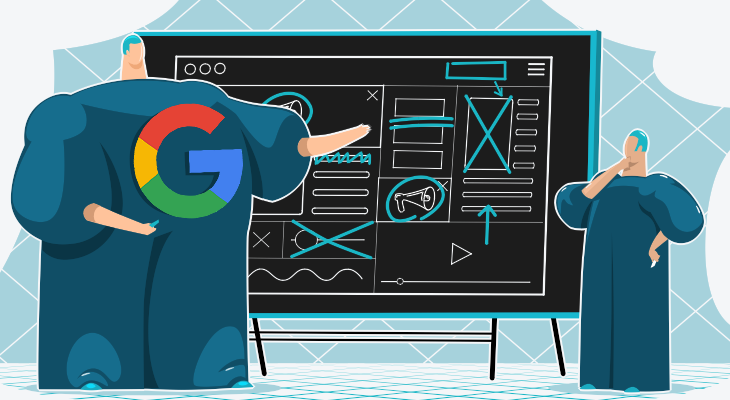September Helpful Content Update & How to Recover From It
If your site experienced a decline after the September Helpful Content update (HCU), it could be because it relied too much on algorithmically tailored content and less on genuine user value.
Google hasn’t yet defined the goal of HCU, but it has made significant changes in the definitions and content documentation.
This update seems to elevate original, helpful content crafted for your audience, emphasizing quality and user relevance. Thus, it promotes sites that provide in-depth, authentic information while lowering sites that rely too much on search-engine-driven tactics over true user engagement.
Main Changes in the September 2023 Helpful Content Update
Google’s September 2023 Helpful Content update significantly alters how Google assesses and ranks content on the internet. It primarily focuses on the helpfulness and real-world relevance of the content.
There’s a clear emphasis on quality, authenticity, and first-hand experience.
Sites relying heavily on traditional SEO tactics without genuine content might face declines. In contrast, platforms that enable real people to share authentic experiences might see improvements in their rankings.
Additionally, the update provides a more nuanced view of AI-generated content. Instead of outright penalization, Google evaluates such content on its merit – its quality, relevance, and alignment with user intent.
In essence, the Helpful Content update pushes website owners and content creators towards producing more authentic, user-centric, and high-quality content, irrespective of whether humans or AI creates it.
Setupad Expert Opinion
Arvis Renckulbergs, SEO manager at Setupad: “Since Google just finished rolling out the September HCU, there usually are fluctuations in rankings for a few weeks from the day the rollout has completed. During this time, be cautious when taking any drastic steps regarding your site. As Google is still evaluating the new results, your page might revert to where it was before the drop. However, you can freely make on-page improvements that contribute to the page speed and user experience, such as image optimization, meta information updates, H1 tags fixes, meta descriptions improvements, and any other on-page issues that might cause UX, crawlability or indexing issues.”
Here are the 4 main aspects of the changes (we’ll dive deeper into each aspect below):
- The update revises the guidance on AI-generated content.
- There are warnings against false updates to pages (caution against fake “freshness” in the search results).
- New points about hosting third-party content on your site.
- New guidance for those affected by the update and what to do (Google advises to identify and eliminate unhelpful content).
Additionally, Google has modified the language in their helpful content system documentation:
- Instead of “content written by people for people” it says “content created for people.”
- Instead of “Is this content written by an expert” it says “Is this content written or reviewed by an expert”.
Change to guidelines on machine-generated content
The system learns from examples labeled as helpful and unhelpful, primarily provided by Google’s quality raters.
The objective is to model the kind of content that users find useful. Google’s primary concern is content quality, whether it’s human-written or AI-generated.
The Helpful Content update emphasizes the need for content to be tailored to specific audiences, reflecting expertise, and matching user intent. While AI-generated content isn’t automatically penalized, low-quality content, irrespective of its origin, is.
Third-party content and continuous classification in Google’s Helpful Content System
Third-party content hosted on a primary domain or subdomains is included in these site-wide assessments, prompting Google’s advice to prevent indexing such content if it differs from the main site’s intent.
When Google’s systems review whether your site produces helpful content, the helpfulness of the content on subdomains can impact this examination. Note that the unhelpful content classification is a site wide signal, which can impact the rankings even of your helpful content.
The classifier functions continuously, adjusting rankings based on the current content quality, and Google communicates significant changes to its detection methods through “helpful content updates”.
Whatsoever, it’s important to note that despite the rollout of Google’s HCU in September 2023, third-party hosted content remains largely unaffected.
Although Google’s documentation mentions a crackdown on low-quality third-party content, it hasn’t been implemented in the algorithm yet. Certain sites using redirect tactics saw traffic surges on the update’s release day.
While some deceptive practices still persist, it’s speculated that future Google updates might target and potentially decline such content.
The future of AI content
There’s an ongoing debate about an “arms race” between detecting AI-generated content and improving AI content quality. As AI content becomes better, it might become more prevalent in content consumption.
Note: Google supports the ethical use of AI in content creation, but human oversight is essential. Google will penalise content that is of poor quality.
AI-produced content can be improved by using the CRAFT editing methodology–clarity, optimisation, graphics, fact-checking, and trust-building.
Helpful Content Update Impact
The Helpful Content system is an AI-powered mechanism that classifies websites based on their helpfulness. A sharp decline in Google traffic around the rollout time indicates that the system might have labeled the site as having low value or not being helpful.
This classification affects the site as a whole.
Quality remains the critical factor. Content should adhere to guidelines, avoid manipulative tactics, and uphold clarity, optimization, visuals, fact-checking, and trust-building.
What is Helpful Content?
“Helpful Content” is a system devised by Google Search to ensure that users are presented with original and genuinely beneficial content in search results.
The system functions by generating a signal, considered among various other signals, to analyze the utility and originality of content.
Its main objective is to:
- Favor content that provides a satisfactory user experience, and downgrade content that does not meet users’ expectations.
The effect of these rankings is weighted, with sites containing larger proportions of unhelpful content potentially facing more substantial ranking decline.
Why it’s important for publishers?
The Google’s Helpful Content system emphasizes the importance of originality, relevance, and user satisfaction in content.
For publishers, adhering to these standards is crucial not only for search engine rankings but also for establishing trust and credibility with their audience. Producing high-quality, user-centric content always helps to improve user experience.
This system is engineered to reward content that genuinely benefits the reader.
As a publisher, you should take into consideration these 3 aspects:
- Traffic implications. Publishers who notice a dip in traffic, possibly due to this system, should introspect and improve or eliminate any content perceived as unhelpful. A decline in traffic can significantly impact ad revenue and overall site credibility.
- Long-term impact. Although the classifier runs continuously, the implications of being labeled as “unhelpful” might linger for months. This long-term effect emphasizes the importance of maintaining content quality consistently.
- Guidance for improvement. For publishers unsure about their content’s helpfulness, Google offers guidance (search quality rater guidelines) on producing reliable, user-centric content. Following this guidance can not only enhance rankings but also provide readers with a superior experience.
What types of websites or content were most affected?
The Google September 2023 Helpful Content Update most prominently affected websites lacking genuine user value.
For example, websites making unsupported health claims in recipes, featuring lengthy and redundant introductory sections, and those that redirect users to ads instead of promised content (e.g., a recipe) experienced significant traffic drops.
A common trend among negatively impacted sites was a lack of depth and originality in content. Many tried to rank for various topics without substantial insight or unique offerings.
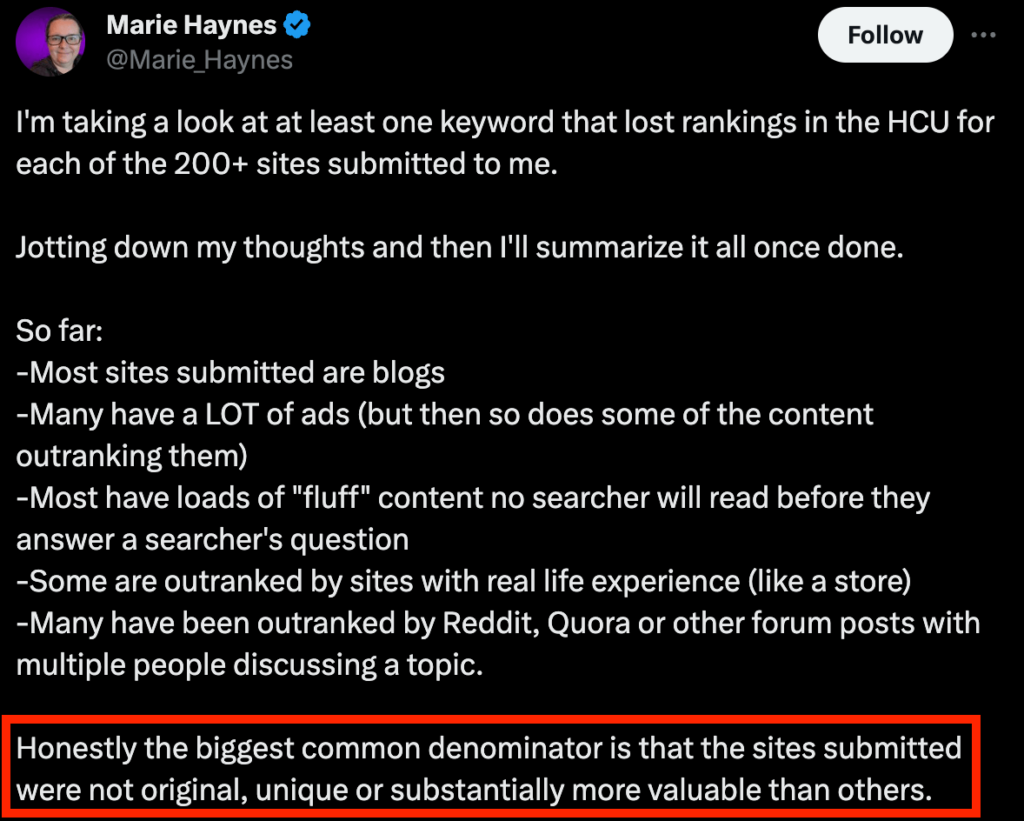
Source: Twitter
Additionally, poor user experience, signified by outdated designs, broken navigation, and intrusive pop-up ads, also seemed to be a trigger. Another critical observation was the reduced rankings for websites that lacked transparency about content authors and their expertise.
Essentially, content that appeared to exist primarily for monetization, without prioritizing user value, faced challenges from this update.
Impact on SEO-reliant content
Sites relying heavily on SEO tactics might experience a decline in traffic. The update seems to demote content that lacks real-world experience or is not considered authoritative on its topic.
Main aspects of Google September 2023 Helpful Content Update
| Aspect | Explanation |
| Update name | Google September 2023 Helpful Content Update |
| Launch date | September 14 at 4:20pm ET |
| Completion date | September 28 at 3:00am ET |
| Target | Content that prioritizes search rankings over usefulness. |
| Platform impact | Google Search and Google Discover. |
| Penalty details | No explicit penalty mentioned, but impacts sites not aligning with the update’s intentions. |
| Promotion & demotion | Promotes helpful content and demotes unhelpful content. |
| Scope of impact | Sitewide (entire websites are affected). |
| Nature of update | Not a core update. |
| Language & geographic scope | Global, across all languages. |
| Impact’s focus area | Notably impacts online educational materials, entertainment, shopping, tech content. |
| Recovery recommendation | Review and improve content based on Google’s advice. |
| Refresh rate | Scores are updated constantly, recovery might take several months. |
| Role of E-E-A-T | Essential for determining content quality. Trust is the most pivotal aspect among them. |
Do Higher Ad Density Impacted Sites More Negatively?
Considering that the update is literally about “helpful content” and a good user experience, it’s possible that Google’s algorithm started penalizing websites with high ad density if it compromised the user experience.
Thus, if sites have a higher ad density that disrupts the user experience, it could be one of the reasons for a dip post-update.
We looked at the websites in our network that were hit the most severely by this update and we found that all websites experienced the drop because of SEO-related issues, not ads.
- As an example we’re taking website X.
The website has experienced a severe traffic drop. However, according to the data, the revenue has been consistent with the website traffic. Everything else, including eCPM, is stable. If we look at page and session RPM, there are even minor improvements in user value and its page views.
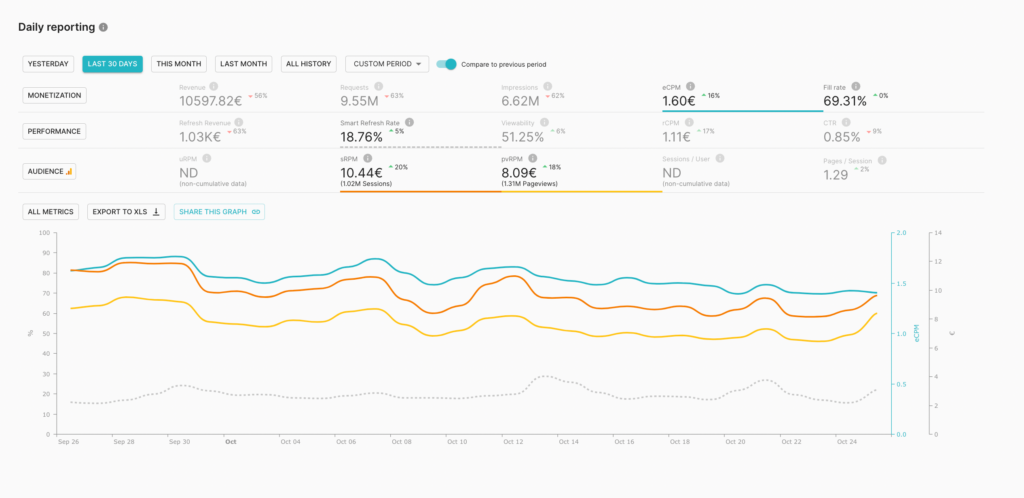
Below you can see that around the time the Helpful Content update came around, the website X’s organic traffic decreased by -1.6K. This indicates that the site is potentially losing visibility for some high-traffic keywords or seeing reduced click-through rates.
The decline post the spike could mean that while there was an initial positive response to the update (potentially due to content modifications or other on-site changes), the benefits weren’t sustained in the long run.
This could be due to several reasons such as increased competition, change in user behavior, or external factors.
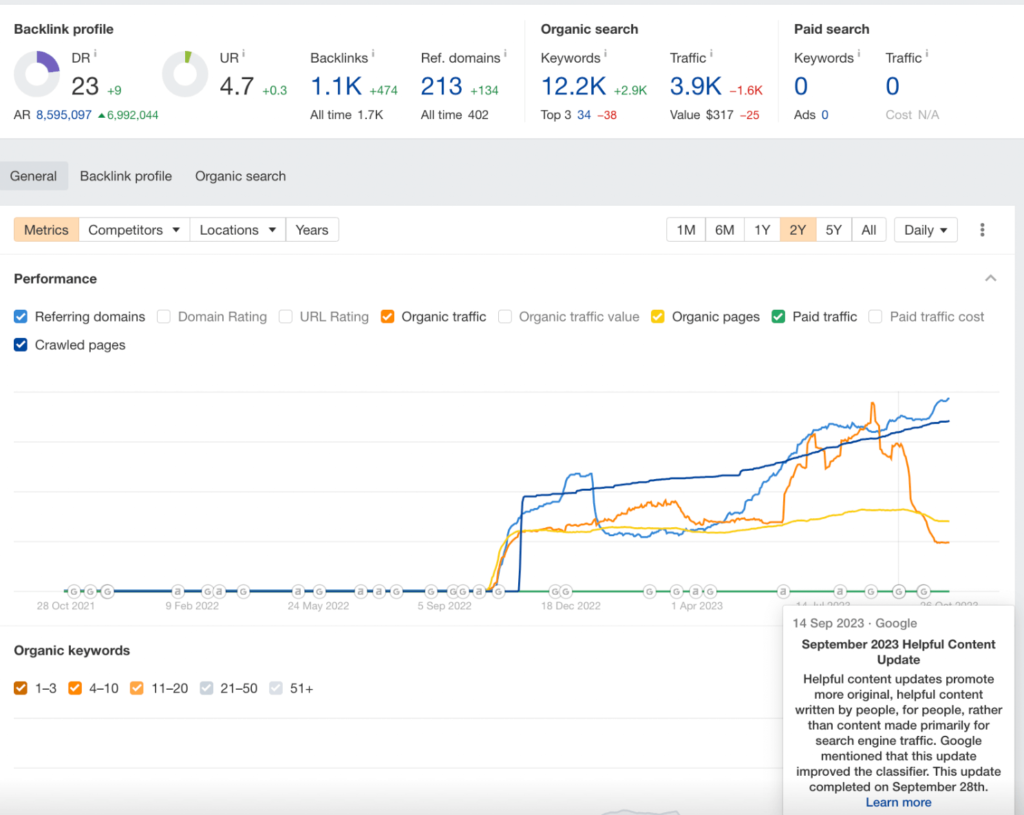
Website X might need to delve deeper into its content strategy, ensuring that the content is SEO-optimized and offers users genuine value. This means–updating content, addressing user feedback, and optimizing for user intent.
Additionally, analyzing which specific keywords lost traffic can help pinpoint specific areas for improvement.
Recovering From the Helpful Content Update
Google emphasizes that genuine, audience-focused content remains vital in content creation. While SEO is essential, it shouldn’t compromise the authenticity and relevance of the content.
Google’s responses emphasize that writing for the sole purpose of search engine rankings, without prioritizing the human audience, is deemed unhelpful. Instead, content should be produced with a clear understanding of its purpose, addressing the–who, how, and why–it’s being created.
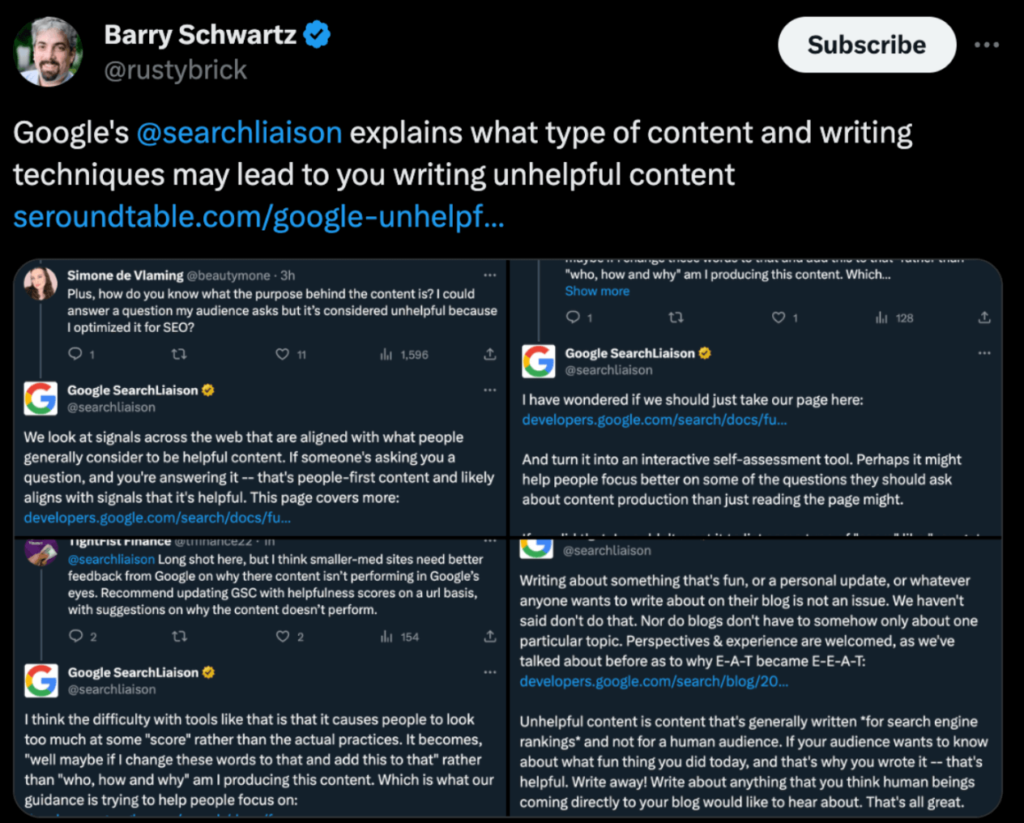
Source: Twitter
What immediate action can you take to regain lost traffic or rankings?
If Google’s new update has impacted your website’s content, the tech giant provides several recommendations.
Firstly, you should self-assess your content, especially if you’ve observed noticeable traffic fluctuations potentially linked to the system. Any identified unhelpful content should be either amended or removed.
Google directs users to their help page, which guides publishers in creating helpful, people-centric content by focusing on a few essential questions beforehand.
For those who have made changes, it’s crucial to understand that the recovery and acknowledgment by Google’s system might take several months. This is due to the classifier’s continuous operation, which ensures the absence of unhelpful content in the long run.
The overarching message is clear: prioritize creating content that genuinely serves and informs the audience.

Source: Google Search Central
In addition, you should analyze the websites that are now ranking in SERPs where your page used to rank, and see what those pages have done better than you.
Setupad Expert Opinion
Arvis Renckulbergs, SEO manager at Setupad: “It could be the content of the page, better images, or more helpful content. For example, if you have a recipe page, images play a crucial role, so you should use high-quality images with descriptive alt texts. Another important consideration is schema markup – again, very useful for recipe pages, but also for product category pages, job listings, tabular data, etc.”
Best practices for updating content to align with the new update’s standards
First of all, be sure to stay updated with Google’s guidelines. Their recommendations and guidelines evolve and change over time (e.g., core updates, spam updates, etc.), therefore it’s important to regularly check for any new updates and adjust your content strategy accordingly.
Here are 7 tips for you to create content that would align with the new Google’s HCU:
1. Focus on your audience
Before making any changes, understand who your audience is, their needs, and how your content can address those needs.
Content should always be crafted with the reader in mind.
Additionally, encourage user comments and feedback. It helps to understand what your audience thinks about the content and what are the areas of potential improvement.
2. Authenticity is the key
Ensure that your content is genuine, original, and not just created for the sake of improving search engine rankings. Avoid excessive keyword stuffing and ensure your content reads naturally.
3. Promotion of user-generated content
Platforms with user-generated content, where real people share genuine experiences, seem to have performed well after the update.
The suggestion is that Google now rewards firsthand experience more.
4. Deep dive into topics.
Instead of superficially covering multiple topics, delve deeper into subjects. Provide comprehensive and detailed information that offers value to the reader.
5. Regular content review.
Periodically review and update your content to ensure it remains current, accurate, and relevant. This includes checking and updating links, statistics, and any dated information.
Your content should be presented in an easily uderstandable format. This includes clear headings, bullet points, relevant images, and infographics.
6. Engage with multimedia.
Incorporate relevant videos, podcasts, and other multimedia elements. This not only enhances user experience but can also provide a richer context to your content.
7. Last but not least–quality over quantity.
Instead of producing a large volume of content, focus on creating fewer, high-quality pieces that are well-researched and offer significant value to your audience. Be sure to remove or enhance pages that have little to no valuable content.
Low-value content can significantly harm your site’s credibility and overall ranking.
Focus on E-E-A-T (Experience, Expertise, Authoritativeness, Trustworthiness)
E-E-A-T stands for experience, expertise, authoritativeness, and trustworthiness, and represents the criteria Google considers when evaluating content quality.
Among these, trust is paramount.
While E-E-A-T isn’t a direct ranking factor, Google’s systems use factors that identify strong E-E-A-T qualities, especially for YMYL (Your Money or Your Life) topics, which are subjects that can greatly impact individuals’ health, financial stability, safety, or societal welfare.
Search quality raters, individuals who assess Google’s algorithm effectiveness, use the search quality rater guidelines to gauge a content’s E-E-A-T strength.
However, their feedback doesn’t directly influence rankings but serves as a measure of algorithmic success. Reviewing these guidelines can help content creators align with the attributes Google’s automated systems prioritize in ranking.
How to enhance the E-E-A-T score of your content?
Here are 7 tips to keep your E-E-A-T score high:
- Author expertise. Ensure that content is produced by qualified individuals, particularly on YMYL topics. Highlight their credentials and relevant experience.
- Credible citations. Reference authoritative sources and studies to back up claims, demonstrating thorough research and a commitment to accuracy.
- Clear author identification. Make sure each piece of content clearly identifies its author, ideally with a bio that showcases their expertise on the subject.
- Quality backlinks. Garner backlinks from reputable, high-authority websites, indicating your content’s value and credibility to the wider web community.
- Engage with users. Respond to comments and feedback, demonstrating active engagement and a commitment to user trust.
- Regularly update content. Ensure information remains current and accurate, revisiting and updating older content as needed.
- User experience. Prioritize a good user experience on your website, ensuring it’s secure (using HTTPS), mobile-friendly, and easily navigable.
The importance of author credentials, citations, and high-quality backlinks?
Establishing the expertise of content authors is vital, especially for YMYL topics. Author credentials serve as proof that the information presented is knowledgeable and trustworthy.
Citations from reputable sources bolster the credibility of content, indicating thorough research and a commitment to providing accurate and reliable information.
Backlinks from authoritative websites act as endorsements, signaling that the content is valuable and respected within the industry or topic area. This not only enhances E-E-A-T but also directly influences search engine rankings.
User Experience and Engagement:
How does user experience (UX) tie into the update?
User experience is intricately linked to the update because Google aims to promote sites that offer users a seamless, intuitive, and satisfying experience.
A better UX not only ensures visitors stay on the site longer, but it also encourages them to explore more pages, leading to higher engagement.
Setupad expert opinion
Arvis Renckulbergs, SEO manager at Setupad: “User experience is an indirect ranking factor and should be taken very seriously. For example, if page titles are too long, this impacts the user experience–titles that are too long might be truncated in SERPs and users might not understand what your page is about. The optimal page title should be from 40 to 55 characters. Another example is missing meta descriptions–this, too, is an on-page optimization issue that doesn’t directly impact the rankings, but is geared towards UX, as meta descriptions can be seen under the page title in SERPs and entice visitors to either click on your page or ignore it.”
Which user engagement metrics should you pay attention to?
You should closely monitor metrics like bounce rate, average session duration, and pages per session, as these provide insights into how well your content resonates with your audience and how effectively your site’s design facilitates user navigation.
Content Depth and Quality:
Longer content or more in-depth and relevant content?
While longer content might seem comprehensive, the depth and relevance of the content matters more. Google prioritizes content that provides value, answers user queries, and delves deep into the subject matter rather than just provides surface-level information.
How to ensure content quality meets Google’s new expectations
To ensure your content meets Google’s expectations, focus on thorough research, citing credible sources, and presenting information clearly. It’s essential to regularly update content to reflect current information, get rid of out-dated information and ensure that the topics are relevant to your website.
Keep it original, trustworthy, and highly value user satisfaction on your website. Engaging with user feedback can also boost site’s quality and relevance.
Long-Term Strategy Alignment:
How should you change their content strategy moving forward?
We’ve gathered the 7 main tips for you to improve your content strategy after the update:
- Create helpful content.
Content should be created with the user’s needs in mind. Ensure that what you’re producing is both useful and informative, answering questions or providing solutions that users are searching for.
- Keep the content relevant and up-to-date.
Outdated information can be misleading and unhelpful. Regularly review and thoroughly refresh your content to reflect your field’s most recent data, studies, or best practices.
- Fix thin content/pages on your website.
“Thin” content refers to pages with very little useful information. Such pages might be seen as low-quality by search engines. Enhancing these pages with more detailed and relevant information can improve their perceived quality.
- Include expertise and personal experience.
Content rooted in personal experience or professional expertise seems to be valued more by the new update. By sharing unique insights or lessons you’ve learned, you can add depth and authenticity to your content.
- Make significant changes to your content if you decide to update it and change the publishing date.
Simply updating the date of a post without making substantive changes can be misleading to readers. If you’re updating the publish date, ensure the content has been significantly updated or improved.
- Improve content that has dropped in the search results.
Google Search Console provides insights into how your content performs in search results. If you notice a decline in rankings or traffic for specific pages, revisit and optimize them. This might involve improving the quality, adding new information, or addressing technical SEO issues. Also, go through the page indexing reports – if there are pages with indexing, redirect or other issues, make sure to fix them.
- Review and improve AI content (if you use it), don’t just copy and paste it.
While AI-generated content can be a useful tool for content creation, it should not be used as-is. Human review is essential to ensure the content is accurate, coherent, and aligns with your brand’s voice.
Always tailor AI-generated content to make sure it provides real value to your readers.
Conclusion
In light of the Google Helpful Content update of September 2023, publishers should prioritize producing original, high-value content that genuinely serves users’ needs over content crafted merely for search engine traffic.
This update emphasizes Google’s shift towards rewarding content written for authentic audiences, emphasizing quality, relevance, and depth.
For those seeing fluctuations in their metrics, it’s crucial to reevaluate and refine content strategies. Get rid of unuseful content, host third-party sites that align with your domain’s value, include expertise and personal experience in your content, and ensure regular, meaningful updates.
Since true user-centric narratives are becoming the preferred form of content creation, publishers must adapt and prioritize real value over algorithmic acceptance.
